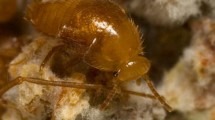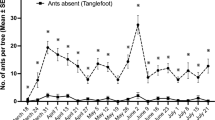Abstract
The damage to plantations by pests is often determined by perceptions rather than objective data, resulting in excessive use of pesticides. Leafcutter ants are considered important pests to plantations in America. We evaluated the difference in Pinus taeda biomass consumption by four Acromyrmex leafcutter ant species which co-inhabit plantations of this pine species. These ants exhibit morphological and behavioral differences, i.e., Ac. heyeri has mandibles adapted to cut monocots, while the other species cut dicots, which may result in differences in their consumption of pine. We collected the plant biomass that ants carried into their nests and recorded the foraging activity in different seasons throughout a year. The P. taeda biomass carried into leafcutter nests was less than 20 % compared to total plant biomass. Colonies with greater foraging activity carried a greater amount of total biomass, but they did not carry more pine biomass. The leafcutter ant species studied differed in their use of pine biomass, but not of total biomass. Acromyrmex ambiguus and Ac. crassispinus were the species carrying the greatest amount of pine biomass and with more colonies using pine, whereas very little amounts of pine were carried by Ac. heyeri and by very few colonies. Thus, leafcutter ant species do not cause the same damage to pine plantations. Our results also highlight the importance of pest management strategies based on a thorough knowledge of the biology of the species, including those characteristics which can predict the use that each species will make of the plantation.



Similar content being viewed by others
References
Barnola LF, Hasegawa M, Cedeño A (1994) Mono-and sesquiterpene variation in Pinus caribaea needles and its relationship to Atta laevigata herbivory. Biochem Syst Ecol 22:437–445
Bernays EA, Jarzembowski EA, Malcolm SB (1991) Evolution of insect morphology in relation to plants. Philos Trans R Soc B Biol Sci 333:257–264. doi:10.1098/rstb.1991.0075
Cantarelli EB (2005) Silvicultura de precisao no monitoramento e controle de formigas cortadeiras em plantios de Pinus. Dissertation, Universidade Federal de Santa Maria
Cantarelli EB, Costa EC, Pezzutti R, Oliveira LS (2008) Quantificação das perdas no desenvolvimento de Pinus taeda após o ataque de formigas cortadeiras. Ciência Florest 18:39–45
Crawley MJ (2007) The R book. Wiley, New York
Della Lucia TMC, Gandra LC, Guedes RNC (2014) Managing leaf-cutting ants: peculiarities, trends and challenges. Pest Manag Sci 70:14–23. doi:10.1002/ps.3660
Fassola H, Crechi EH, Barth SR, Keller AE, Winck RA, Martiarena R, Von Wallis A, Pinazo MA, Knebel O (2010) Regional prediction models for aboveground biomass estimation of Pinus taeda in Misiones and NE Corrientes region, Argentina. 14 Jornadas Técnias Forestales y Ambientales. Facultad de Ciencias Forestales, UNaM-EEA Montecarlo, INTA, Misiones, Argentina
Fowler HG (1985) Leaf-cutting ants of the genera Atta and Acromyrmex of Paraguay (Hymenoptera: Formicidae). Dtsch Entomol Zeitschrift 32:19–34
Fowler HG (1988) Taxa of the neotropical grass-cutting ants, Acromyrmex (Moellerius) (Hymenoptera: Formicidae: Attini). Científica 16:281–295
Fowler HG, Pagani MI, Da Silva OA, Forti LC, Silva VP, Vasconcelos HL (1989) A pest is a pest is a pest? The dilemma of neotropical leaf-cutting ants: keystone taxa of natural ecosystems. Environ Manag 13:671–675
Guillade AC, Folgarait PJ (2014a) Natural enemies of Atta vollenweideri (Hymenoptera: Formicidae) leaf-cutter ants negatively affected by synthetic pesticides, chlorpyrifos and fipronil. J Econ Entomol 107:105–114
Guillade AC, Folgarait PJ (2014b) Competition between grass-cutting Atta vollenweideri ants (Hymenoptera: Formicidae) and domestic cattle (Artiodactyla: Bovidae) in Argentine rangelands. Agric For Entomol 17:113–119. doi:10.1111/afe.12085
Hill DS (1983) Agricultural insect pests of the tropics and their control. Cambridge University Press, Cambridge
Hölldobler B, Wilson EO (1990) The ants. Harvard University Press, Cambridge
Montoya-Lerma J, Giraldo-Echeverri C, Armbrecht I, Farji-Brener A, Calle Z (2012) Leaf-cutting ants revisited: towards rational management and control. Int J Pest Manag 58:225–247
Newsom LD (1967) Consequences of insecticide use on nontarget organisms. Annu Rev Entomol 12:257–286
Nickele MA, Reis Filho W, Batista de Oliveira E, Iede ET, Caldato N, Strapasson P (2012) Leaf-cutting ant attack in initial pine plantations and growth of defoliated plants. Pesqui Agropecu Bras 47:892–899
Pimentel D, Acquay H, Biltonen M, Rice P, Silva M, Nelson J, Lipner V, Giordano S, Horowitz A, D’Amore M (1992) Environmental and economic costs of pesticide use. Bioscience 42:750–760
R Development Core Team (2013) R: a language and environment for statistical computing. R Foundation for Statistical Computing, Vienna, Austria. http://www.R-project.org/
Varón EH, Eigenbrode SD, Bosque-Perez NA, Hilje L (2007) Effect of farm diversity on harvesting of coffee leaves by the leaf-cutting ant Atta cephalotes. Agric For Entomol 9:47–55
Vasconcelos HL (1990) Foraging activity of two species of leaf-cutting ants (Atta) in a primary forest of the Central Amazon. Insectes Soc 37:131–145. doi:10.1007/BF02224026
Zanetti R, Zanuncio JC, Santos JC, da Silva WLP, Ribeiro GT, Lemes PG (2014) An overview of integrated management of leaf-cutting ants (Hymenoptera: Formicidae) in Brazilian forest plantations. Forests 5:439–454
Zovi D, Stastny M, Battisti A, Larsson S (2008) Ecological costs on local adaptation of an insect herbivore imposed by host plants and enemies. Ecology 89:1388–1398. doi:10.1890/07-0883.1
Acknowledgments
Abedul S. A. allowed us to carry out our study in their plantations and helped with several logistic issues. Sandra Las Heras Ruiz and Carolina Gomila helped with field work. We thank two anonymous reviewers and the editor for helpful comments to improve the manuscript. This project was funded with a Grant to PJF by the Ministry of Agriculture (SAFO 112—MAGyP). LE and PJF thank CONICET. MAF and AG thank MAGyP.
Author information
Authors and Affiliations
Corresponding author
Additional information
Communicated by C. Cutler.
Rights and permissions
About this article
Cite this article
Elizalde, L., Fernández, M.A., Guillade, A.C. et al. Know thy enemy: interspecific differences of pine consumption among leafcutter ants in a plantation. J Pest Sci 89, 403–411 (2016). https://doi.org/10.1007/s10340-015-0702-y
Received:
Revised:
Accepted:
Published:
Issue Date:
DOI: https://doi.org/10.1007/s10340-015-0702-y




